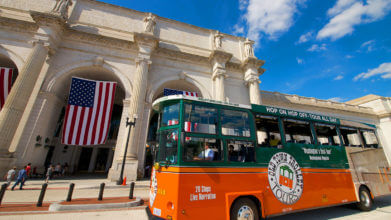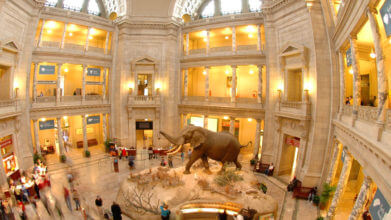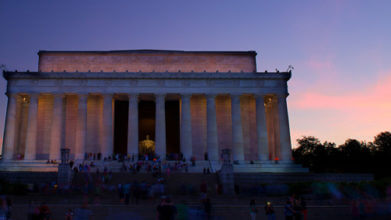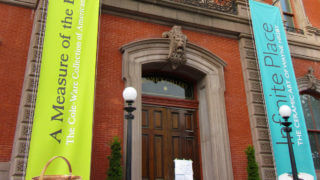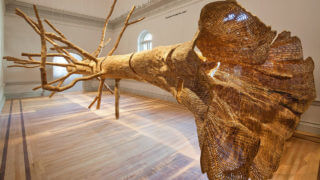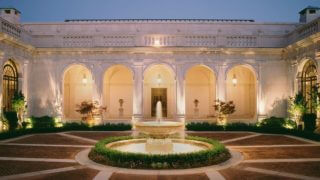Freer and Sackler Galleries of Art – Smithsonian Castle
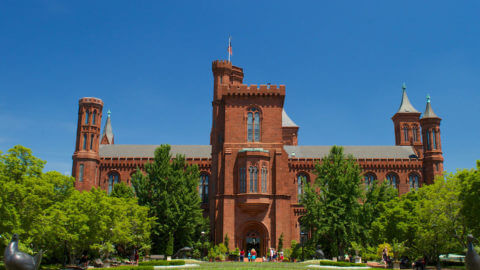
The Smithsonian Castle, officially known as the Smithsonian Institution Building, stands as a gateway to the many treasures of the Smithsonian Institution. Located near the National Mall in Washington, DC, this striking red sandstone structure has been a centerpiece of cultural and scientific exploration since its completion in 1855. Designed by architect James Renwick Jr., the Smithsonian Castle blends elements of Gothic Revival with Norman-style architecture, creating a structure that is both timeless and rich in historical significance. Whether you’re a history enthusiast, architecture admirer or simply curious about the Smithsonian’s offerings, this guide will help you explore the castle’s fascinating past and plan a memorable visit.
A Visitor’s Guide to and History of the Smithsonian Castle
History of the Smithsonian Castle
The story of the Smithsonian Castle begins with the vision of British scientist James Smithson, whose generous bequest in 1829 provided the foundation for the Smithsonian Institution. A national design competition was held in 1846 to choose the architect for the institution’s first building, with James Renwick Jr.’s Gothic Revival design being selected. Renwick’s design, which drew inspiration from medieval European architecture, became a symbol of the Smithsonian’s role in preserving knowledge and culture. Renwick’s portfolio also includes notable works like St. Patrick’s Cathedral in New York City and the Smithsonian’s Renwick Gallery, also located in Washington, DC.
Construction of the Smithsonian Castle began in 1847 utilizing red Seneca sandstone from a quarry in Montgomery County, Maryland. While the stone’s warm hue adds to the building’s striking appearance, it also holds a complex history, as enslaved individuals were employed in quarrying the stone. The building’s East Wing was completed in 1849, housing Secretary Joseph Henry and his family, while the West Wing followed later that year. Despite setbacks, including a structural collapse in 1850 that prompted a shift to fireproof construction methods, the castle’s exterior was finished by 1852, and its interior was completed in 1855.
Throughout its history, the Smithsonian Castle has faced challenges and changes. A fire in 1865 damaged the upper story and towers, requiring significant restoration efforts. Despite the challenges it has faced, the building endures, standing as a testament to the Smithsonian’s dedication to learning and scholarship. In 1965, the Castle was designated a National Historic Landmark, cementing its place as an iconic part of the National Mall. Today, it functions as both a visitor center and the administrative heart of the Smithsonian Institution, providing guests with insights.
Interesting Facts About the Smithsonian Castle
First Smithsonian Building
The Smithsonian Castle was the first structure built for the institution, setting the stage for the 19 museums and galleries that now make up the Smithsonian network. This iconic building not only served as the institution’s first home but also played a crucial role in shaping the Smithsonian’s mission of preserving knowledge. It remains a symbol of the institution’s commitment to education and preservation, serving as a cornerstone of Washington, DC’s cultural heritage. Visitors often find it fascinating to explore the origins of the world-renowned Smithsonian Institution through the history embedded in this building.
Gothic Revival Architecture
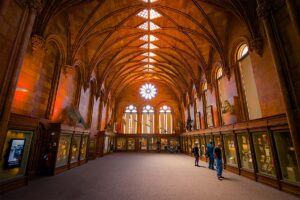
A Site of Resilience
The Castle survived a devastating fire in 1865 that destroyed much of its upper story, including the north and south towers. Thanks to careful restoration, it retains its historical character while continuing to serve as a vital part of the Smithsonian, welcoming millions of visitors each year. The process of rebuilding required detailed craftsmanship and dedication to preserve its original design, ensuring that the Castle remains a testament to the resilience and enduring spirit of the Smithsonian Institution. Its ability to withstand such adversity adds to its significance, making it a symbol of perseverance and renewal.
Hub of Information
As the institution’s visitor center, the Castle helps guide over a million visitors each year, offering exhibits, maps, and essential information about the other Smithsonian museums. It serves as a welcoming point for those beginning their exploration of the National Mall. Whether you’re looking for recommendations on must-see exhibits or a deeper understanding of the Smithsonian’s history, the Castle provides the resources to enrich your visit and make the most of your time in the nation’s capital.
Original Design Evolution
There were a number of design proposals before Henry Bacon’s more classical Parthenon-inspired design was ultimately chosen for the National Mall’s layout. While these early designs never came to fruition, they reflect the creative vision and ambitions behind the Smithsonian’s presence in Washington, DC. The final design, with its Gothic Revival style, was a decision that balanced tradition with the desire to create an enduring landmark that would stand the test of time.
Restoration Efforts
The Castle is currently undergoing a major renovation that began in 2023, aiming to restore elements like the Grand Hall to its original 19th-century appearance while enhancing the visitor experience for the modern era. This ambitious project will include updates to accessibility and technology, ensuring that the building remains a welcoming space for future generations. These updates will ensure its legacy endures, preserving the integrity of the historic structure while providing a fresh perspective for those who visit. The renovation also includes improvements to the surrounding Enid A. Haupt Garden, making it an even more inviting space for relaxation and reflection.
Know Before You Go
Location and Accessibility
The Smithsonian Castle is centrally located on the National Mall, offering easy access to visitors exploring Washington, DC’s cultural sites. Its proximity to other attractions makes it a convenient stop for anyone touring the area. The building is wheelchair accessible, and ramps ensure that all visitors can navigate the space comfortably, making it an inclusive experience for everyone. The accessible pathways and helpful staff ensure that all visitors, regardless of mobility, can fully appreciate the history and beauty of the Castle.
Old Town Trolley Tours®
For those looking to explore Washington, DC, including the Smithsonian Castle, Old Town Trolley Tours® offers a convenient way to navigate the city. Their hop-on, hop-off tours include a stop at the Castle, allowing visitors to explore at their own pace while enjoying the trolley’s informative narration about DC’s history and attractions. It’s an ideal option for those seeking a flexible tour experience, providing an easy way to see the city’s landmarks without the stress of finding parking or navigating unfamiliar streets.
Visiting Hours
The Smithsonian Castle is open daily, but hours may vary depending on events and ongoing renovations. It’s always best to check the Smithsonian’s website before your visit for the latest information and ensure you don’t miss any special exhibits or activities. Early morning visits can be especially serene, offering a quieter experience before the crowds arrive, while evening visits allow you to see the Castle beautifully illuminated.
Dining Options
While the Castle itself does not have a dedicated café, its location on the National Mall means that a variety of dining options are just a short walk away. From casual food trucks offering quick bites to nearby museum cafés that serve sandwiches and salads, there’s something for everyone.
Things To See at the Smithsonian Castle
Smithsonian Information Center
Start your visit at the Smithsonian Information Center, located inside the Castle. Here, you can pick up maps, get recommendations, and learn about current exhibitions and events happening across the Smithsonian’s museums. It’s the perfect starting point for first-time visitors seeking a comprehensive overview and a way to plan their day efficiently. The center’s knowledgeable staff can help you discover hidden gems and tailor your visit to your interests.
Gothic Revival Architecture
Take time to appreciate the intricate architectural details of the Castle. Its pointed arches, turrets and textured stone walls reflect the romanticism of the Gothic Revival style, offering plenty of photo opportunities and a chance to admire 19th-century craftsmanship. The Castle’s architecture is not just visually stunning; it also tells a story of a time when design was meant to inspire awe and reflect the importance of the institution it housed.
Educational Programs and Tours
The Castle offers guided tours that provide deeper insights into its history, architecture, and the story of the Smithsonian Institution. These tours are perfect for visitors looking to gain a more comprehensive understanding of this landmark and its pivotal role in American culture. Tour guides share fascinating anecdotes and little-known stories that bring the history of the Castle to life, making it an enriching experience for history enthusiasts of all ages.
Enid A. Haupt Garden
Adjacent to the Castle, the Enid A. Haupt Garden spans 4.2 acres and offers a serene escape from the bustling city. The garden features diverse plant species and beautifully maintained pathways, making it a perfect spot for a leisurely stroll or a peaceful break. With seasonal blooms and shaded seating areas, the garden provides a lovely place to relax, enjoy a book or simply take in the beauty of nature amid the cityscape.
Interactive Exhibits
Inside the Castle, interactive displays allow visitors to explore the Smithsonian’s history, mission, and extensive collections. These exhibits are engaging for all ages, offering a hands-on way to learn about the institution’s global impact and its commitment to education. From touchscreens that bring history to life to detailed models of other Smithsonian museums, these interactive features make the experience both fun and educational.
Art and Artifacts
Throughout the Castle’s hallways, you’ll find art and historical objects that provide a glimpse into the Smithsonian’s vast collections. From early artifacts to rotating exhibitions, there’s always something new to discover, making each visit a unique experience. The displays offer a window into the past, showcasing items that tell stories of scientific discovery, cultural milestones, and artistic achievements.
Nearby Things To Do
- Smithsonian National Museum of Asian Art: Located nearby, this museum offers a rich collection of Asian art and artifacts, making it a great follow-up to your visit to the Castle. Explore exhibits that span thousands of years of history.
- National Museum of African Art: Explore the artistic traditions of Africa with a visit to this museum, which showcases sculptures, textiles and contemporary works from across the continent. It’s a cultural experience that highlights the diversity of African creativity.
- Explore the National Mall: Take a stroll along the National Mall, where you can visit iconic landmarks such as the Washington Monument, the World War II Memorial, and the Lincoln Memorial, all within walking distance of the Smithsonian Castle. It’s the perfect way to immerse yourself in America’s historical landmarks.Smithsonian National Museum of Natural History: Discover the wonders of the natural world at this nearby museum, home to famous exhibits like the Hope Diamond and the Hall of Fossils. It’s an educational experience for the whole family, offering insights into Earth’s history.
FAQs
What is inside the Smithsonian Castle?
Inside the Smithsonian Castle, you’ll find the Smithsonian Information Center, which serves as a gateway to the institution’s many museums. Visitors can explore informative exhibits that showcase the history and mission of the Smithsonian Institution. The Castle also features exhibits that highlight unique artifacts from across the Smithsonian’s collections, providing a rich introduction to the diverse museums nearby.
How old is the Smithsonian Castle?
The Smithsonian Castle was completed in 1855, making it over 160 years old. Its long history includes serving as the first home of the Smithsonian Institution and playing a central role in the organization’s growth. In 1965, it was recognized as a National Historic Landmark, preserving its status as a key cultural site in Washington, DC. This designation ensures its historical importance is protected for future generations.
What family-friendly activities are available at the Smithsonian Castle?
The Smithsonian Castle is a fantastic destination for families, offering interactive exhibits and educational displays that engage visitors of all ages. Guided tours provide a deeper understanding of the Castle’s history and architecture, making learning fun and immersive. Children will enjoy the adjacent Enid A. Haupt Garden, where they can explore colorful plant life and enjoy the open spaces. The Castle’s welcoming atmosphere makes it a great stop for families exploring the National Mall and seeking a fun, educational experience.

